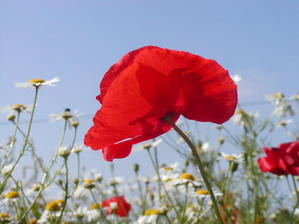Aarhus, Denmark
January 19, 2009
 |
|
More weeds in the fields in the
spring will – all things being equal – lead to greater
biodiversity. This can be done using GMO. Photo: Janne
Hansen |
Source:
Aarhus University
Growing crops that are genetically
modified to be resistant to the herbicide glyphosate can affect
the fauna and flora in fields and hedgerows in both a positive
and a negative way. The farmer’s spraying strategy makes the
difference.
Having more weeds in the field is beneficial for insect life –
and a large and varied insect population means a rich and varied
diet for birds. If the farmer can leave his sprayer in the shed
a bit longer in the spring so that a certain amount of weed
cover is allowed to grow, then biodiversity can bloom.
This would, however, entail increased use of herbicides on the
whole, since larger weeds need a larger dose. If the crops are
genetically modified to be resistant to the herbicide
glyphosate, then it is possible to avoid increasing the dose as
much as in conventional crops, according to results set out in a
recent Danish report on a project financed by the Environmental
Protection Agency. The report was prepared by scientists from
the Faculty of Agricultural Sciences and the National
Environmental Research Institute, both at
Aarhus University, and the
Faculty of Life Sciences at the
University of Copenhagen.
- If you want to increase weed cover in the spring by postponing
herbicide treatment, then it would be possible to do so in crops
that are resistant to glyphosate with a smaller increase in
treatment index than is possible in conventional crops, says
head of research unit Niels Holst from the Department of
Integrated Pest Management at the Faculty of Agricultural
Sciences, who is a co-author of the report.
Herbicides spread
The surrounding hedgerows will be affected almost no matter
which spraying strategy is used. Herbicides will drift dependent
on wind and weather. Compared with the flora in hedges around
unsprayed fields, there will be fewer plant species – and the
amount of available food for insects and birds will also be
limited.
The species composition in the hedge will reflect which
herbicides have been used in the field through the years. The
plant species that are most tolerant to the herbicides used will
be dominant. If glyphosate-tolerant crops (GT crops) are grown,
then the flora in the hedge around the field will be dominated
by species that tolerate a certain amount of glyphosate.
Glyphosate and biodiversity
In order to increase farmland biodiversity it would be a great
help to have more weeds in the fields in the spring. The weeds
can reach a size that can provide a habitat and food for fauna.
This is possible – without impairing crop yield in the field –
by postponing herbicide treatment.
This would require a larger dose of herbicide when treatment
finally takes place. Well-developed weeds require more herbicide
to control them than very young weeds. Glyphosate is an
efficient compound to this aim but the requirement is that the
crop in the field does not suffer. This is where GT crops enter
the scene.
- If you compare the dosage increase that is necessary with
glyphosate with that of other compounds, then glyphosate will
lead to a smaller increase in treatment index than the others.
Therefore, in GT crops it would be possible to postpone
treatment with a smaller increase in treatment index than in
conventional crops, Niels Holst points out. At the same time the
farmer can be more certain of a satisfactory result when using
glyphosate in a late spraying than with other compounds.
Change in attitudes necessary
Part of the project investigated farmers’ attitudes to growing
GT crops. The study showed that special incentives are required
in order to get farmers to change their spraying behaviour
enough to achieve a positive effect on biodiversity.
Unsurprisingly, an important requirement is that the change is
profitable. Apart from that, GT crops also meet with practical
barriers including the need for them to fit into the existing
crop system.
There are also attitude barriers. There is significant
scepticism with regard to accepting the rise in weed population
that results from growing GT crops and spraying so late in the
season that a positive effect on biodiversity is achieved. This
applies even if the late spraying is not a problem with regard
to crop yield.
In other countries a concentrated use of glyphosate has led to
an increase in glyphosate-resistant weeds. The project
concludes, however, that farmers can avoid this problem by
alternating between GT crops and conventional crops. Practising
this would require alternating between herbicides, which, in
turn, would prevent development of resistance.
For more information please contact: Head of research unit Niels
Holst, Department of Integrated Pest Management, Faculty of
Agricultural Sciences, Aarhus University, telephone: +45 8999
3591, email:
Niels.Holst@agrsci.dk
by Janne Hansen |
|